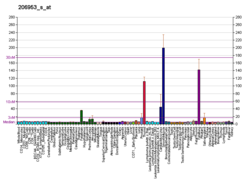Latrophilin 2 is a protein that in humans is encoded by the ADGRL2 gene.[5][6]
This gene encodes a member of the latrophilin subfamily of G-protein coupled receptors (GPCR). Latrophilins may function in both cell adhesion and signal transduction. In experiments with non-human species, endogenous proteolytic cleavage within a cysteine-rich GPS (G-protein-coupled-receptor proteolysis site) domain resulted in two subunits (a large extracellular N-terminal cell adhesion subunit and a subunit with substantial similarity to the secretin/calcitonin family of GPCRs) being non-covalently bound at the cell membrane. While several transcript variants have been described, the biological validity of only one has been determined.[6]
- ^ a b c GRCh38: Ensembl release 89: ENSG00000117114 – Ensembl, May 2017
- ^ a b c GRCm38: Ensembl release 89: ENSMUSG00000028184 – Ensembl, May 2017
- ^ "Human PubMed Reference:". National Center for Biotechnology Information, U.S. National Library of Medicine.
- ^ "Mouse PubMed Reference:". National Center for Biotechnology Information, U.S. National Library of Medicine.
- ^ White GR, Varley JM, Heighway J (Apr 2000). "Genomic structure and expression profile of LPHH1, a 7TM gene variably expressed in breast cancer cell lines". Biochimica et Biophysica Acta (BBA) - Gene Structure and Expression. 1491 (1–3): 75–92. doi:10.1016/s0167-4781(00)00020-8. PMID 10760572.
- ^ a b "Entrez Gene: LPHN2 latrophilin 2".




